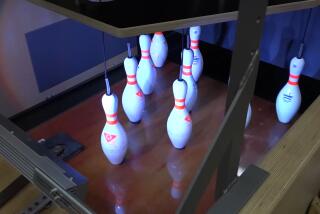Game Players Drawn by Chance to Win Money, Forget Troubles : Lite-a-Line Lives On as Pike’s Last Glimmer
- Share via
They come to Long Beach from all around to play the game. From Los Angeles and the San Fernando Valley. From Riverside and San Bernardino.
They are Asian refugees, bored housewives, business people out for a lark, would-be gamblers. They share a fascination for steel balls aimed at tiny holes and flashing yellow lights governed by skill and luck. Armed with spring-loaded pinball shooters and stacks of quarters, they stare intently forward as the fates tempt them on.
Not a sound can be heard save the gentle rumbling of balls on tables as the silent contestants bend solemnly to their task. This is Lite-a-Line, a bingo-like game where money changes hands in the last remaining remnant of the Nu-Pike amusement area. For some, it is a way of life.
“The night that sign goes out, the Pike is closed,” said Al Brown, 77, who has worked in this building for more than 60 years. In the meantime, he said, business is quite satisfactory.
The sign he refers to is a neon fixture atop this quaint domed building in what is now a nearly abandoned downtown parking lot. It bears a name closely linked to the history of these parts. The name is Looff, as in Charles Looff, creator of the city’s first hand-carved carrousel, which debuted in this very building in 1911 as centerpiece to the then-new Pike amusement park. Or Arthur Looff, the great carver’s son, who went into partnership with Brown in 1941 to create Lite-a-Line in the building once occupied by the famous merry-go-round.
Simple Rules
The rules of the game, played on what looks like a pinball machine, are simple. The object is to be the first player in the 64-table room to land balls in five holes in a line. A player’s progress is charted on a board on which hits are indicated by yellow and green lights. Games last until somebody wins, which generally takes two to three minutes.
In 1961, after 20 years of legal haggling during which Brown was occasionally jailed and his business closed, a Los Angeles Superior Court judge ruled that Lite-a-Line was a game of skill rather than chance. Games of chance--considered gambling--violate California law.
Today, players pay 50 cents a game and earn $10 to $25 each time they win.
“It’s just one of those things,” said the old carnival man, shaking his head in trying to explain the continuing attraction of the game he has run from a tiny memento-filled office since Arthur Looff’s death in 1970. “It’s just the closeness you come to winning all the time.”
But the business has changed over the years, he said.
Back in the 1940s, when the Pike was at its peak, Brown said, playing Lite-a-Line was a standing-room-only proposition. Then came the closing of the amusement park in 1979 and, with it, the gradual disappearance and razing of Pike-related businesses. Today Lite-a-Line--which stands near a bar, a raggedy-looking apartment house and two condemned buildings--is virtually the only Pike amusement still operating. Nearby is the last of what once was a string of tattoo parlors.
Declining Business
“We don’t have any drop-ins anymore,” said Brown, referring to Pike customers who wandered over to play Lite-a-Line. Because of that and the recent proliferation of bingo, he said, business has declined 40% since 1979.
Still, the game--which operates seven days a week from noon to 2 a.m.--employs a rotating staff of 30. And on an average weeknight, said shift manager William Mundy, about 40 to 50 people can be found there honing their Lite-a-Line skills.
Most, said Brown, are regulars who have been playing for years or discovered the game recently by word of mouth. And like the city’s general population, he said, players in recent years have represented a greater ethnic diversity, including a particularly high presence of Asians.
“I come when I’m lonely,” said Noy Sypraoeuth, 24, a Laotian immigrant who said he has lived in the United States for four years and worked for a water bed manufacturer.
Others had different reasons for being there. Renee Castillo, who owns a restaurant in North Long Beach, said she comes about once a week when she is “really tired and my mind’s messed up and I need to relax.” To avoid spending too much money, she said, she never brings more than $10.
“It’s fun,” said Castillo, 44, who said she had walked off with as much as $140 on particularly lucky nights. “You concentrate on getting the ball in the hole and you leave your troubles at home.”
‘My One Freedom’
And Ed Wasserman, 41, who lives in Whittier and subsists on odd jobs, said he plays Lite-a-Line two or three times a week for as long as seven hours at a stretch. “It’s my one freedom,” said Wasserman, adding that he seldom wins and generally loses between $10 and $70 per sitting. “I’ve known about it since I was a kid.”
Brown said he realizes the game can’t go on forever. His building is in a city redevelopment area earmarked for condominiums. “It’s just a matter of time,” he said, before he must close.
But the thought doesn’t bother him. “I’ve resigned myself to it,” Brown said.


